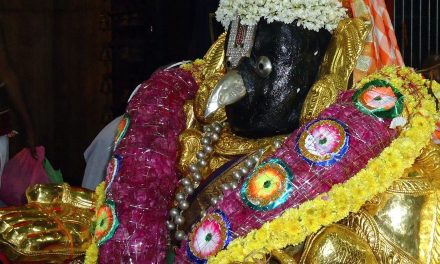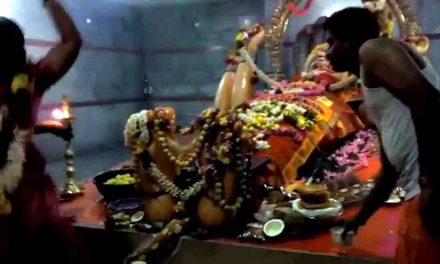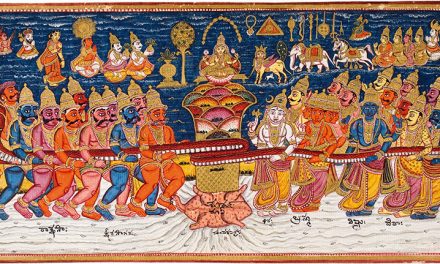The holy dhama of Ahobilam is populated by nine prominent Forms of Lord Narasimha, worshipped throughout the Ahobilam Hills. These Nava Narasimha Kshetra manifestations of the Lord are surrounded by many other Nrsimhadeva shrines located throughout the countryside of Andhra Pradesh.
The upper Ahobilam temple is located at about 2,800 ft. above sea level and is positioned in a valley between two sacred hills: Garudadri and Vedadri, through which the River Bhavanasani flows. These two hills are conceptualized as the separation of the pillar from which the ferocious Lord Narasimhadev emerged to destroy Hiranyakasipa.
The Vedadri Lakshmi Narasimha Swamy temple is located on the River Krishna, approximately 10 kms. from Chillakallu, near Vijayawada. Here, Ugra Narasimha is the presiding Deity.
The temple structure is conventional, being brightly colored and ornamented with a variety of images. A beautiful Form of Narasimha Swami in yoga pose (above) greets devotees on the outside of the temple. The Lord is joined by murtis of Lord Varaha, Laksmi devi, Garuda, Hanuman, and other transcendental personalities and figures. The utsava idols are extraordinarily high and impressive, and the dwajasthamba of imposing girth and height. In the waters of the Krishna River, Lord Narasimha can also be found in Salagram form.
The Vadapalli temple is situated in Nalgonda district near the town of Miryalaguda, at the confluence of the River Krishna and Musi River. These two rivers very unusually come together in the shape of an “L”.
Vadapalli is also a famous place of worship for Lord Shiva’s devotees. The two main temples are the Sri Lakshmi-Narasimha Swami temple and a Sri meenakshi Agasteswara temple, which was constructed by the Kakatiya rulers in the 12th century. There, a Shivalinga is said to always hold a certain level of water, no matter how much water is removed.
There are Puranic references to the history of Lord Narasimha’s appearance at Vadapalli. According to the Puranas, Vyasa Bhagavan, knowing the piousness of the place, meditated for a long time on the manifestation of Sri Narasimha Swamy. The Lord benedicted him by manifesting in his ferocious Ugra form.
Vyasa Bhagavan experienced Lord Narasimha at the moment when His breath was filled with tremendous anger, so he concluded that the Lord had come to him just after killing Hiranyakasipu. Therefore, he prayed to Sri Narasimha Swamy to manifest at Vadapalli in that Form only. Accordingly, Lord Narasimhadeva manifested there to bless the devotees and to alleviate their suffering. Even now, it is said that the Deity breathes in out. The temple priests have arranged two lamps here. One lights the face of the Lord and can be seen to quiver, as evidence of the fact that the Lord is continually breathing in and out. The second lamp, kept below, burns resolutely.
The Vadapalli and Vedadri temples in Krishna District are also understood to be two of a group of five Narasimha temples which together, form a holy dhama, or religious collective. The other three temples in the group are located at Mattapalli in Nalgonda District, Ketavaram and Mangalagiri in Guntur District.
Although built during different time periods, these five Sri Narasimha temples are connected historically, by the devotees’ worship of the Deities, and through their iconography. Author Dr. Anu Vedagiri has published a scholarly study of these five temples in her book, “Five Narasimha Temples in Andhra Pradesh” (2004). In her book, she identifies three prevalent iconographic themes that are associated with the five temples. These include the role of Laksmi devi as the primary servant of Narasimhadev, the importance of the Krishna River, and the underlying Tantric affiliation within the Vaisnava ritual practices in the temples.













